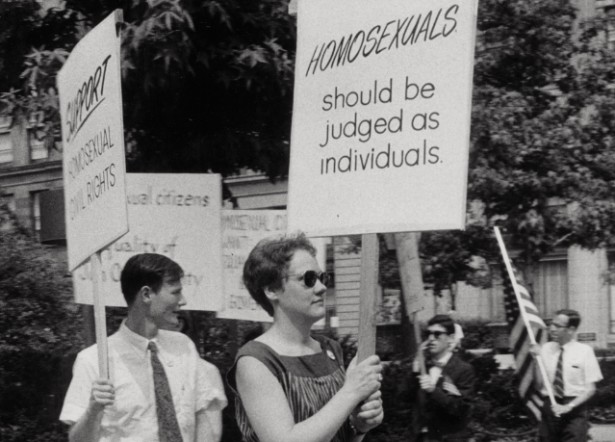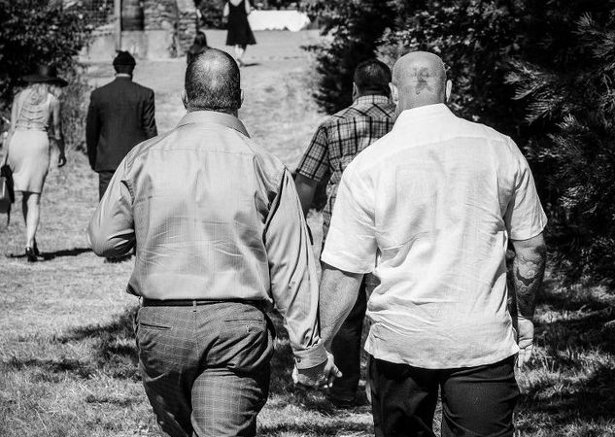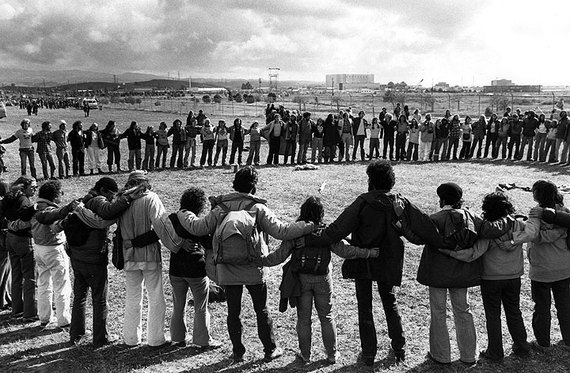Now that the LGBTQ movement in the United States has reached the half-century mark, what can activists learn from its story of struggle? Since polarization continues to deepen, this might be a good time to learn from a movement whose enemies once felt so panicked that some suggested gays be put in concentration camps to protect society from AIDS.
As a young man living in Philadelphia in the late ‘60s, cautiously coming out to friends, I was aware of demonstrations for gay rights at Independence Hall led by Barbara Gittings and others. I was too scared to join them. By then I’d already risked in the civil rights and peace movements, even in a war zone in Vietnam, but publicly coming out as gay seemed even scarier than getting seriously injured.
Previous Coverage
 What white allies can learn from allies in the gay rights struggle
What white allies can learn from allies in the gay rights struggleOnce publicly known as gay, I’d face the unknown: living a drastically changed life. I was right. In the early ‘70s, when I did come out via a speech to a thousand people at a national Quaker conference, my life was forever altered. Doors closed. My marriage, family and role as an activist were impacted on every level.
Support also appeared, even from unexpected places. I found ways to be of use, and even to flourish, despite it all.
I also learned that coming out would be a powerful nonviolent tactic to add to the methods of noncooperation in Gene Sharp’s classic taxonomy. It turns out that gay oppression, to remain stable, needs us to remain invisible.
It was around this time when a high school student named Steve Chase invited me to speak on peace in his school assembly in Illinois. I did so, and came out in the context of the speech. I later learned about the ruckus I’d caused, or rather, the ruckus Steve had caused. Called to the principal’s office to explain himself, he admitted he expected me to come out, even though he didn’t ask me to. He wanted it to stir school-wide discussion, which it did. As Steve pointed out to the principal, it might have saved the life of a gay classmate who was pondering suicide.
Nevertheless, there were times I overlooked the strategic power of coming out. One such instance was when I disparaged some leading gay organizations’ choice to focus on equal marriage and equality in the military. I was for liberation and questioned both traditional marriage and the military. What I missed was that the fight for equality in those institutions would spur many additional people to come out. The tactic would itself support their own liberation and add power to the overall movement.
For me, coming out meant stepping into a new place of freedom. As feminists were teaching us at the time, “the personal is political; the political, personal.” I hit the streets, recruited in bars for boycotts, got arrested and supported organizers. I learned more about love and solidarity. I also saw some tactics and strategies that today’s movements can use right now.
We learned from those who’d gone before us
In the decades before 1969, when drag queens in New York City led the Stonewall rebellion, civil rights had been “the mother of all movements” in the United States. Like African Americans, LGBTQ people were a minority whose oppression was enforced by rejection, job and housing discrimination, bullying, church burnings, police brutality, corruption and killings.
Partly because of the civil rights struggle, a spirit of defiance was spreading among LGBTQ people. In 1959 LGBTQ people confronted police officers at Cooper’s Donuts in Los Angeles, and in 1966 drag queens rose up in Compton’s Cafeteria in San Francisco. These outbursts revealed readiness to risk. In the rhetoric of the day, “We’re sick and tired of being sick and tired!”
Previous Coverage
 Get real about privilege — become an ally
Get real about privilege — become an allySpontaneous outbursts, however, aren’t likely to gain change. Intention increases the chance of winning. In 1965, Philly’s chapter of the Janus Society led a gay sit-in at a Dewey’s restaurant, prompting an end to the restaurant’s discrimination practice. That was followed by nonviolent defiance orchestrated by New York’s Mattachine Society in Julius’ Bar, resulting in the dropping of a discriminatory regulation.
The results were consistent with the civil rights movement’s experience, whose greatest successes came from direct action campaigning. That movement confronted even the Ku Klux Klan and won victory after victory in the Deep South.
We could see that drama can ignite “movement moments,” as when in Greensboro the four black students on Feb. 1, 1960 sat in and began a wave of nonviolent direct action campaigns across the South.
The June 28, 1969 uprising at the Stonewall Inn also sparked a movement moment. The action, reportedly a mix of violence and nonviolence, certainly was dramatic. Unlike Greensboro, Stonewall didn’t model for us what should be done next. How to make use of the energy that was unleashed? The Gay Liberation Front, however, made use of the energy that was unleashed, putting together a coalition to create the first pride march, the Christopher Street Parade.
In both Greensboro and New York, the combination of drama and organization got the movement moving.
When marches matter
My friends know me to be very skeptical about the strategic value of marches. Considering the energy that goes into a major march, and knowing the much greater power of direct action campaigns, I’m known to ask for the compelling strategic reasons for each march I hear about.
However, I started this article the day after I donned the bright purple shirt my grand-daughter Raquel gave me and, yet again, joined a pride parade. I see four strategic reasons that justify a pride march, even 50 years after Stonewall.
LGBTQ oppression has an unusual feature: It tries to make sexual and non-binary gender difference invisible. To spotlight our tactic of direct noncooperation, the parade makes us out, loud and in numbers.
Proudly calling public attention to the part of us that has been despised also inspires others who are still cooperating with the oppression. Many of us know people who first were onlookers before taking the risk to join the march itself.
The march provides a visible on-ramp for mainstream community leaders and office-holders, non-gay family members, and even the usual enforcers — like police, who join the march in uniform — to declare “which side they’re on.”
Along with growth in numbers over time I noted differences in who was there. Now there are more people of color, more young people (even teenagers holding hands), more inter-racial couples. The growth in the marches is important in two ways. For us as a minority with some internal tensions around our differences, growth signals solidarity. Growth also reveals to the power-holders our force as an interest group.
During the parade, I found myself frequently smiling and crying, sometimes simultaneously. I kept remembering my best friend Gary, one of the early casualties of AIDS.
My strong feelings reminded me again of the model of the civil rights movement, where displays of emotion were frequent. Both movements have provided strong containers for feelings: anger, grief, self-affirmation, despair, fear, sense of agency, shame, joy, acceptance.
Working with anger while aiming for strategy
Participants in ACT-UP were famous for expression of anger about the criminal neglect of AIDS from government, Big Pharma and hospitals. Their campaigns forced a sea change in research, policy and practice and saved countless lives. I recommend for all groups the film “How to Survive a Plague” to stimulate discussion about strategy and tactics.
In 1991, Philadelphia police rioted on unarmed, whistle-blowing demonstrators outside a hotel where President George H.W. Bush was speaking. Eventually the police ended up admitting they’d broken the law and settled with ACT-UP for $61,500.
ACT-UP leaders called me after the beatings and said their members needed more nonviolence training before their next encounter with the police. When I got there, the church basement was packed with angry ACT-UP members who, despite my invitation from their leaders, were in no way interested in nonviolence.
I facilitated a go-round in which each person said one word describing how they felt. The atmosphere was hot. I then acknowledged that nonviolent direct action, like anything, has its upsides and downsides. At the top of the flipchart, I placed the signs for plus and minus, then asked for their responses.
They nearly filled the chart with minuses before someone ventured a plus. More minuses were shouted, then a plus, and another and another, then back to minuses.
When the crowd ran out of suggestions, the newsprint was lop-sided on the negative side but a fair number of pluses were up there.
I asked in a neutral tone of voice: “Shall we do a nonviolence workshop tonight?”
A tall man in the back said, “I see the group is ready for the workshop, so I just want to say I can’t picture myself doing nonviolence. But I won’t stand in the way. I’ll show up for the next action but stand across the street so you’ll know I’m there even though I just can’t go with this nonviolence shit.”
A couple of others made similar statements while noting that the group seemed to want the workshop. I waited a beat, then I heard others: “Come on, George, let’s do it!”
It was one of the most electric workshops in my life.
I went to ACT-UP’s next action: civil disobedience, with a very large police presence. The bold, yet unprovocative, behavior of ACT-UP members would have made Gandhi proud. On the sidelines I saw earnest conversation between an ACT-UP leader and the police commander. I got close enough to hear the commander say, “I’m old and near retirement, and I’m just trying to get through this alive.”
The ACT-UP leader looked at him squarely. “Well then now you know how we feel.” He paused. “We want to get out of this alive.” I watched them, in silence, have a moment.
A leaderful movement
Because of the prominence in U.S. history of Martin Luther King Jr., it’s common for people to imagine that a social movement “needs its Dr. King” to achieve a string of victories. The LGBTQ movement never had a uniting, charismatic figure. Its unity, such as it was, sprang from broad agreement on the goal of equality and a diversity of approaches including nonviolent direct action.
People continue to argue about the movement’s vision, including “civil rights” vs. “liberation.” The pride parades themselves include a stunning variety of styles and views, revealing a diversity that marches in the same direction. The parade also includes a welter of hiking, music and other recreational groups that help tie together a network.
Supporting a leaderful movement is the abundance of targets for change. Discrimination in jobs, housing, retail and education operates on many levels: small and large towns, cities, states and the nation. Transgender activists, for example, targeted the mass transit system, successfully campaigning to end gender markers on commuter passes.
Previous Coverage
 4 lessons for climate organizers from the anti-nuclear movement
4 lessons for climate organizers from the anti-nuclear movementLike the climate crisis, gender and sexual oppression invites multiple campaigns and therefore widespread leadership development. As with the successful grassroots movement that prevented the economic elite from achieving its goal of a thousand nuclear power plants, the LGBT movement does fine without a Dr. King.
Movements can win even when some campaigns lose
LGBTQ activists, in common with both the civil rights and anti-nuclear power movements, have had a dynamic relationship between campaigns and the success of the movement as a whole. In all three movements, members organized a variety of targeted campaigns — local, regional and national.
Individual campaigns built organizing skills, courage, and taught each other what works and doesn’t. Even though some of the campaigns didn’t win their immediate goal, all three movements won major gains. National and international movements can win through their aggregate growth and cumulative impact. Like other campaign-focused movements, LGBTQ activists experienced defeats along the way and nevertheless changed this country decisively.
What do generals, Gandhi and gays agree on?
In the 1980s President Ronald Reagan presided over the economic elite’s counter-offensive, designed to roll back progress made by activists in the 1960s and ‘70s. Most liberals and progressives went on the defense, trying to hang onto previously-achieved gains. As billionaire Warren Buffett has observed, the rich have been winning the class war. Most of the movements are today still defending and still losing ground, now with a touch of romance by calling it “the resistance.”
The LGBTQ movement, despite the pain, loss of many talented leaders, disruption, and grave threats caused by AIDS, refused to go on the defense when Reagan moved into the White House. Instead, the movement went on the offense, decade after decade — launching new campaigns for more advanced goals, including rights for trans people.
Bigots who publicly aired their fears of “the homosexual agenda” have been right to be scared. Our agenda is equality, and that means creating more advanced goals with new campaigns to achieve them.
Other movements are starting to re-evaluate their strategy. More American workers were involved in major strikes in 2018 than in any year since 1986. The Sunrise Movement and other climate justice activists are pushing the Green New Deal. They are using the strategic principle that unites gays, Gandhi and military generals: the only way to win is to take the offense.

Awesome analysis with personal reflection= I cried as I feel strong as a movement leader! Thanks for the training and inspiration, George! Love, Firefly